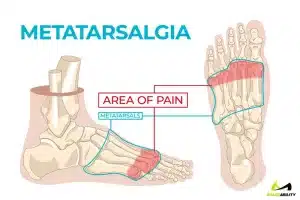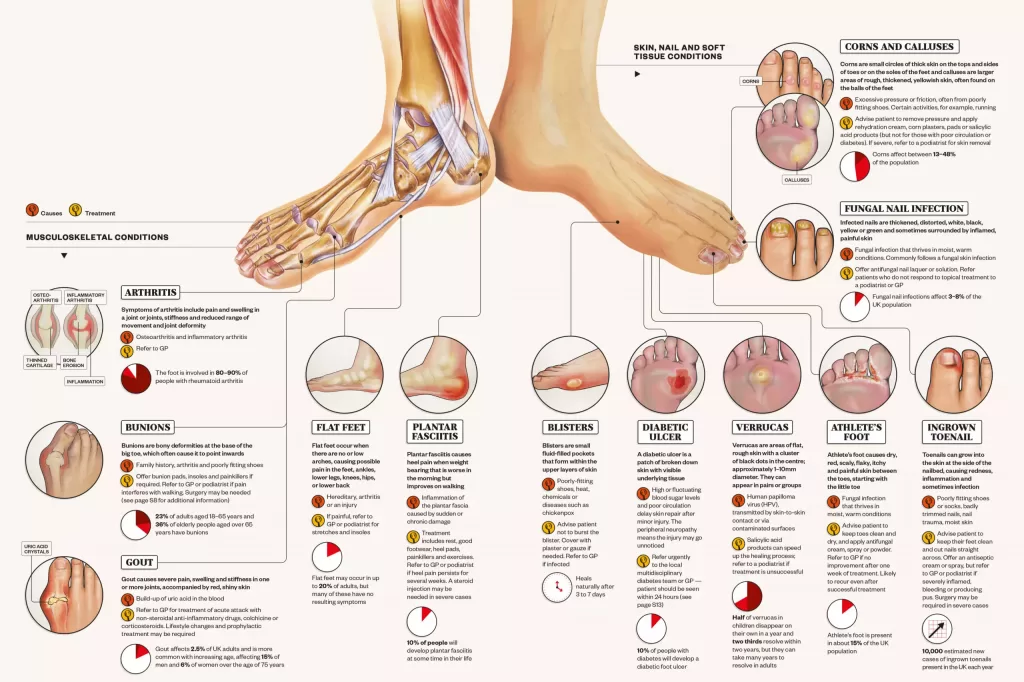
Learn About Foot Pain Types with Diagrams and Charts
Foot pain is a common complaint among adults, affecting daily activities and overall quality of life. Studies estimate that nearly 77% of Americans experience some form of foot pain that hampers their usual routines. While often, it’s a minor injury that heals with time and rest, there can be instances where the discomfort is a symptom of a more serious condition requiring medical attention.
Understanding the type, location, and potential cause of foot pain is essential for effective treatment and prevention. This article provides an in-depth exploration of different types of foot pain. Utilizing foot pain charts, we categorize these various forms of discomfort based on their location on the foot, underlying causes, diagnostic methods, and treatment options.
Foot pain charts serves as a visual guide to help you pinpoint the specific type of foot pain you might be experiencing. It includes sections such as the “foot pain chart top”, which deals with discomfort located at the top of the foot and the “foot pain chart side” that focuses on pain experienced on either side of the foot.
The charts also delves into more specific conditions like “foot pain chart tendonitis”, a condition characterized by inflammation or irritation of a tendon, typically caused by overuse or injury. Another section concentrates on pain experienced on the inner side of the foot, which could be a symptom of conditions like flat feet or tarsal tunnel syndrome.
For those suffering from pain in the arch of the foot, the “foot pain chart arch” section provides insights into possible causes, which can range from plantar fasciitis to fallen arches. The chart also includes a “foot pain chart and cause” section, linking various types of foot pain with their potential causes for a more holistic understanding of the issue.
Other sections like the “foot pain chart outside” and “foot pain chart metatarsalgia” focus on pain experienced on the outer side of the foot and pain in the ball of the foot, respectively. The latter is often caused by wearing shoes with inadequate support or high impact activities like running or jumping.
For runners, who often experience various forms of foot discomfort due to the high-impact nature of their activity, tendonitis or “runner’s foot pain chart” provides a detailed analysis of common foot-related ailments in this demographic.
In conclusion, understanding the various types of foot pain and their potential causes can be an essential first step towards effective treatment. By using the comprehensive foot pain chart provided in this article, you can identify your specific type of foot pain, understand its potential cause, and seek appropriate treatment. However, this chart should not replace professional medical advice. If you’re experiencing persistent foot pain, it’s crucial to consult with a healthcare professional for an accurate diagnosis and treatment plan.
TLDR
Foot pain can be caused by a variety of factors, including overuse, repetitive impact, and underlying medical conditions. Foot pain is a common issue for footwear or insole customers, as feet are the foundation of the body and are subject to high pressure and repetitive impact. By understanding the various types of foot pain, customers can better explain their foot issues to podiatrists and healthcare professionals, and choose the most appropriate treatment options. Below, we breakdown the most common types of foot pain conditions through foot pain charts and diagrams.
Foot Pain and Travel
Before you go anywhere, it’s a good idea to know what kind of foot pain you might be dealing with so you can plan ahead with the right shoes and other preventative measures. For example, if you’re walking a lot, wearing good-quality shoes like sneakers would help keep your feet from getting too sore from overuse. Plus, if you have special shoes made just for your feet, they can provide extra cushioning and help reduce any pain caused by pressure points inside the shoe. Arch supports or heel cups can also help you stay comfortable when you’re walking around all day or exploring new places with uneven terrain like cobbled streets. And don’t forget to stretch your legs before and after any long periods of walking – it can help prevent tired muscles and strained ligaments from causing long-term pain, ensuring a more comfortable journey with valuable travel tips for chronic pain.
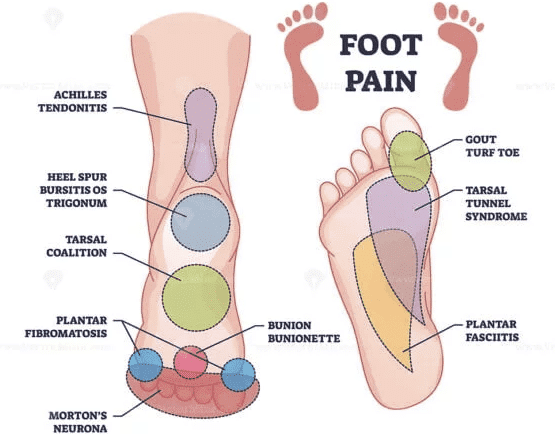
Table of Contents
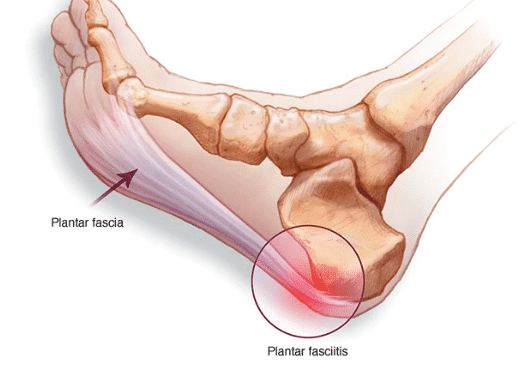
What is Plantar Fasciitis?
The plantar fascia is a thick band of tissue that connects the heel bone to the toes. Looking at the chart, it’s clearly one of the most used and easily inflamed parts of the foot. The pain usually starts in the heel (see diagram) and the arch of the foot. It can feel like a burning or stabbing sensation in the foot. Morning pain is a common symptom of plantar fasciitis.
What causes Plantar Fasciitis?
Plantar fasciitis is an inflammation of the connective tissue between the heel bone and the toes. It can be caused by stress and strain on the foot, especially when you stand for long periods of time, run on hard surfaces or walk badly.
Eventually, if one is not mindful of developing plantar fascia, it can lead to tearing of the fascia band. These tears are painful and can take years to heal. It is at the top of the list of every foot pain chart.
Treating Plantar Fasciitis
1. Rest: Reducing activity levels or taking complete breaks from activities that involve heavy strain on the foot can help reduce inflammation and pain.
This also includes changing footwear if necessary, as certain shoes can aggravate the condition. Here’s our choice for the best shoes for Plantar Fasciitis.
2. Ice: Applying ice to the area for 15-20 minutes several times a day can help reduce inflammation and relieve pain.
3. Orthotics: Insoles in shoes or custom made orthotics can provide additional support and cushioning in the heel and arch areas, reducing discomfort during activities.
4. Strengthening Exercises: Strengthening the muscles in the feet, ankles and calves can help reduce strain on the fascia tissue and improve overall foot health.
5. Stretching: Regular stretching of the heel cord and plantar fascia can help maintain flexibility and reduce inflammation.
6. Medication: Non-steroidal anti-inflammatories (NSAIDs) can help reduce inflammation and pain.
7. Surgery: In some cases, surgery may be necessary to correct the underlying cause of the plantar fasciitis.
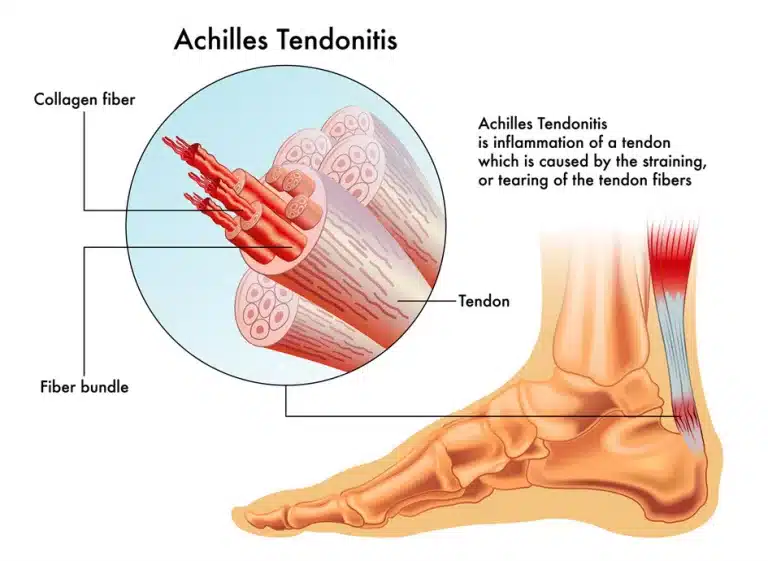
What is Achilles Tendonitis?
Achilles tendonitis is an inflammation of the large tendon in your heel that runs from the calf to the heel bone. It usually develops on the back of your heel and can appear as a sharp or tender pain. Because the achilles is not on the bottom of the foot, some foot pain charts and diagrams don’t include it. However, for travelers, Achilles Tendonitis can seriously degrade the quality of one’s travel.
What causes Achilles tendonitis?
Achilles tendonitis can be caused by a variety of things, such as overworking the tendon, overusing the tendon, wearing the wrong type of shoes, or playing high-contact sports. Looking at the chart, we find there is a lot of geography that has the ability to become inflamed. In the diagram one gets a sense of high tight the fibers can become if all the bundles become inflamed.
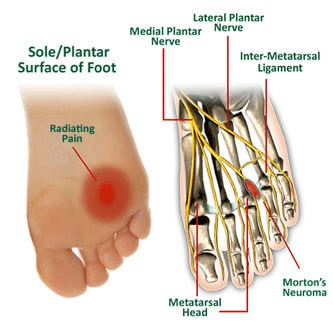
What is a Neuroma?
A neuroma, also referred to as Morton’s Neuroma is a small, harmless growth of nerve cells in your foot. It’s a pain and discomfort-producing condition that affects the ball of your foot as you can see on the left of the chart. The most common symptom of a neuroma is a tingling or numbing sensation between the 3rd and 4th toes as you can see in the right diagram.
Neuromas are caused by repetitive compression of your nerve in front of your foot. This can be caused by tight shoes, high heels or overuse.
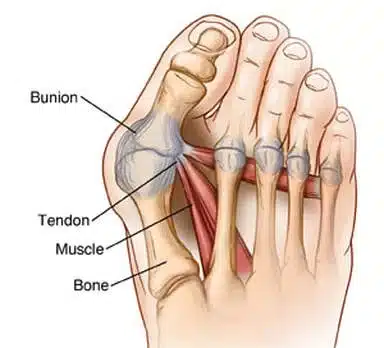
What are Bunions?
Bunions, or toe deformities, rhymes with onions and are bony bumps at the tip of your big toe that cause pain and discomfort. They can also cause swelling or redness in the affected area of your big toe.
Most bunions are caused by your big toe moving towards the smaller ones. This can happen when you wear tight or uncomfortable shoes that put pressure on your big toe.
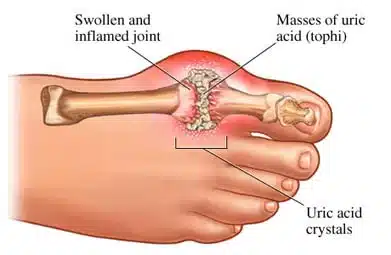
Gout, Turf Toe or Gouty Arthritis
These are all names for a painful form of arthritis caused by an accumulation of uric acid in the joints. It occurs when too much uric acid builds up in the body and forms deposits of sharp-edged crystals in the joint tissue. The most common locations affected are the big toe, ankles, knees, and elbows. The above foot pain chart shows just how gnarly a bad bout of gout can be!
Gout can cause swelling, redness, and extreme tenderness in the affected joint. It can also be accompanied by fever and fatigue. Gout is usually caused by a diet high in purines – such as red meat, shellfish, or alcohol. Treatment includes lifestyle changes to reduce the amount of purines in your diet and medications to reduce inflammation and pain.
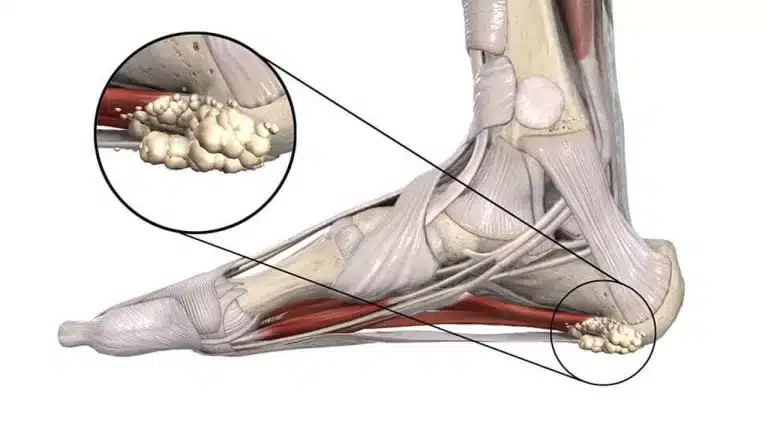
What are Heel Spurs?
Speaking of graphic foot pain charts, the diagram above shows one of the most common and most painful chronic foot pain conditions. If you’re experiencing sharp constant foot pain, it could be caused by a bony projection on your heel bone. This is called a heel spur, and it’s usually located near the arch of your foot. It’s caused by repeated strain on your heel, which can cause inflammation and damage. Over time, calcium deposits can build up in the affected area, leading to a condition called a calcium-filled spur. This can cause a lot of pain when you stand or walk. Treatment for a heel spur can include rest, physical therapy and stretching exercises, and in some cases, surgery could be needed to get rid of the spur. There are lots of different types of foot pain, so it’s important to talk to your doctor and podiatrist to get the best treatment for you.
Are Heel Spurs and Plantar Fasciitis the Same?
In summary, a heel spur is an issue that results from the accumulation of calcium in the bone, referred to as a spur, whereas a plantar fascitis is an inflammation of the ligament. The two issues are often confused, as they can manifest in similar ways.
LESS COMMON CONDITIONS
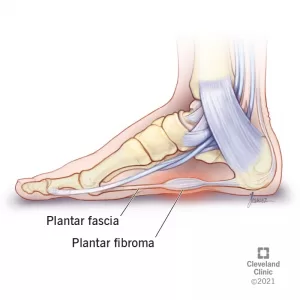 Plantar Fibroma
Plantar Fibroma
What is Plantar Fibroma? Plantar fibroma is a type of tumor that grows in the area of your foot that runs from your heel to your toes. It’s caused by overgrowing the fibrous tissue in your plantar fascia. It can cause pain, swelling, and tenderness in your foot. If you have plantar fibroma, there are a few things you can do to help it go away, like stretching, wearing orthotics, and maybe getting a steroid injection.
Tarsal Coalition
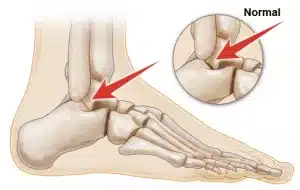
Tarsal Coalition is a rare foot condition in which two or more of the tarsal bones in the foot fuse together. Looking closely at the foot pain diagram on, you can see where the fusion occurs. This fusion can cause a variety of symptoms, including pain, swelling, limited range of motion, and difficulty walking. It usually occurs during childhood or adolescence and is caused by a congenital anomaly. Treatment options for tarsal coalition include bracing, physical therapy, and possibly surgery.
Metatarsalgia
Metatarsalgia is a condition that causes pain and inflammation in the ball of your foot and toes. The pain is often felt as a burning sensation under the toes and can result from wearing tight shoes, high heels, or excessive running on hard surfaces. 